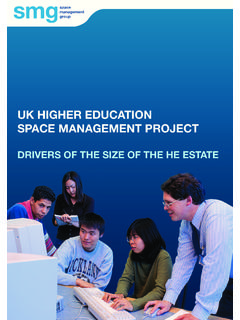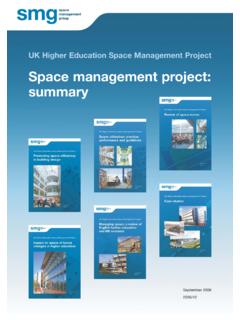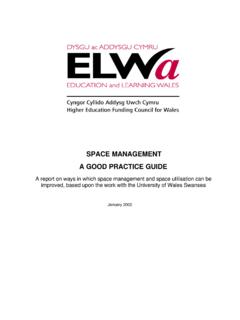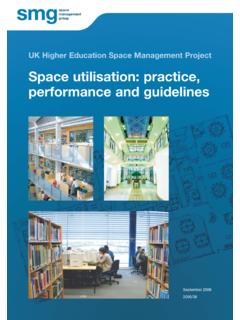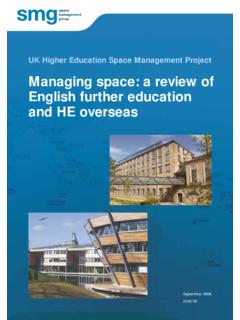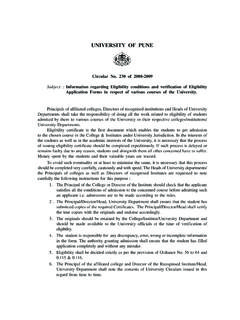Transcription of UK Higher Education Space Management Project …
1 UK Higher Education Space Management ProjectPromoting Space efficiencyin building designMarch 20062006/09 promoting Space efficiency in building designContentsPageForeword21 Executive summary32 Introduction43 Study method74 Results85 Costs and benefits116 Good practice guidance Tools for achieving Space efficiency137 Case study comparisons178 Case studies 1-1523 Appendix: Area definitions103 List of abbreviationsInside back coverPromoting Space efficiency in building design 2006/09 1 AcknowledgementsThanks are due to the many people who helped us during this Project , inparticular the Space Management Group and all those who suggestedpotential case studies, estates teams, staff and student users in the case studyuniversities.
2 We have relied heavily on information provided by estatesdepartments. We have been well supported by a team from Davis LangdonManagement Consulting who helped gather and analyse cost information onthe detailed case studies. Particular thanks are due to Bernard Dromgoole ofHEFCE and Sian Kilner of Kilner Planning, who have helped activelythroughout the report, commissioned by the SpaceManagement Group, provides the link betweenteaching and learning practice and the impact ofdesign on performance (the wow factor ). It is avaluable complement to the SMG report on theimpact on Space of future changes in HE (ref2006/10), and to a study published in March2005 by CABE and sponsored by HEFCE entitled design with distinction the value ofgood building design in Higher Education .
3 Together these reports can provide a stimulus tofurther research, and to more efficient andeffective use of David ChiddickChairman of SMG Vice-Chancellor, University of Lincoln2 promoting Space efficiency in building design 2006/091 Executive summaryThis publication is the outcome of a researchproject conducted by consultants AMA AlexiMarmot Associates for the UK Higher EducationSpace Management Group. The aims were to identify which aspects ofbuilding design contribute most to optimumspace efficiency , and to produce good practicefor establishing Space efficiency within highereducation institutions when embarking onbuilding bulk of the publication comprises 15 casestudies of recent refurbishment, expansion,upgrading or new builds in Higher is a summary of what we have concludedto be 10 key points when seeking optimum spaceefficiency through building design .
4 Below thatare 10 points of good to Space efficiency through buildingdesign (these are expanded on in ) Maximise the built Space on the footprint ofnew buildings and by modest additions andextensions in existing buildings. Match new uses to the existing built form inrefurbishment projects. Provide a high ratio of usable area to grossbuilt area. Capture balance areas for active use. Provide versatile Space , furniture andfittings that can be used for differentactivities. Specify design features that allow differentactivities at different times. Optimise Space standards for effective work. Create versatile office and research Space ,with appropriate open plan areas,supplemented by meeting and quiet spaces.
5 Optimise furniture sizes for effective work. Provide for wireless data access to enablemaximum effective use of common Space . 10 points of good practice for introducingspace efficiency (these are expanded on insection 6) Appoint a champion for spacemanagement and cost in use. Systematically collect and update Space andcost information. Agree targets and monitor their attainment. Collect standardised utilisation data,including office Space utilisation. Collect and apply detailed cost information. Incorporate Space efficiency concepts intothe estate strategy. Incorporate requirements for spaceefficiency into Project briefs, feasibilitystudies, option appraisals and designreviews. Develop and maintain a clear decision andcommunication structure for buildingprojects, including user groups.
6 Promote the benefits of versatile spaces andthe right furniture. Include Space efficiency information in post-occupancy Space efficiency in building design 2006/09 32 Remit and objectivesThe four UK Higher Education funding bodieshave commissioned research into a wide range ofissues relating to Space Management in order tohelp Higher Education institutions (HEIs) managetheir Space in an efficient and sustainable waythat meets their pedagogic, research and supportneeds. This report describes the outcome of researchinto the role of building design in spaceefficiency, reporting to the UK Higher EducationSpace Management Group (SMG) as part of thebroader Space Management Project (SMP). Thestudy remit was to determine how design canmaximise efficient and effective Space use for thefull range of Higher Education functions.
7 Theassumption behind the study is that moreefficient Space is essential in the contemporaryclimate in the Higher Education (HE) sector.(Various definitions of Space efficiency areexamined in section and the appendix.) Further elaboration on our 10 good practice keypoints to improve Space efficiency throughbuilding projects are detailed in section 6. Theycover processes for HE Management and estatedepartments to execute at the estate and buildinglevel. They are based on desk research,experience of Space efficient practice in othersectors and on the findings from our 15 casestudies. All the case studies are in section is ongoing review and debate about theextent to which buildings and their design mayhave an impact on the reputation and success ofan HEI, through the recruitment and retention ofstudents or staff.
8 While recognising that designquality may be important in this respect, thisreport does not explore this potential effect ofthe quality of building design , which is coveredin more detail in a recent report from theCommission for Architecture and the BuiltEnvironment (CABE) Setting the scene Student trends andacademic changeThe context includes the following changeswithin Higher Education : participation in Higher Education has beenincreasing overall, with a greater increase inpart-time undergraduates than full-time2 further increase in student numbers isexpected. The government target of 50% of18-30 year-olds attending HEIs could mean300,000 extra students by 20103 there is greater breadth in the types ofstudents, and new subject areas are rising inimportance (such as non-medical healthprofessions, media and creative arts),combined with new approaches to teachingand learning, and to the use of IT and Setting the scene Impact on thedesign of spaceChanges in Higher Education are beingaccompanied by, and in some cases causing,considerable modifications in buildings in theHEI estate.
9 Space efficiency is improving acrossthe sector, with less Space on average perstudent, institutions offering longer teachinghours, and more pooled Space : there was a small drop in non-residentialnet internal area (NIA) per student full-timeequivalent (FTE) between 1999-2000 and2001-0254 promoting Space efficiency in building design 2006/091 The Commission for Architecture and the Built Environment (CABE), April 2005, design with Distinction: the value of goodbuilding design in Higher Education . Written for CABE and the UK Higher Education Funding Councils by PriceWaterhouseCooperswith research by the University of the West of UK, 2004, Higher Education in facts and figures , Summer 2004, Universities UK, viewed 11 January 2004, Langdon Everest, 2002, Cost model November 2002, available at building Magazine 21st Century University building .
10 4JM Consulting, Teaching and learning infrastructure in Higher Education a report to HEFCE, Ref HEFCE 2002 Management Statistics (EMS), Annual report 2002, available at in 2004, 50% of HEIs were operating withless than m2 NIA per FTE now,compared to 42% in 20006 HEI estates departments are carrying outmany projects specifically to achieve siteand building consolidation. Space efficiency must be balanced against itseffectiveness. New modes of teaching andlearning, for example, often require a largerspace per student within teaching rooms plus theprovision of new student-centred learningenvironments across the estate. Offsetting theseincreased demands means that even greater spaceefficiencies may need to be sought in otherfacilities such as offices.
